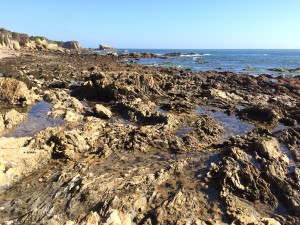 Tide pools, like the ones at Corona del Mar State Beach on the Orange County coast, are ideal places to study marine biology. They hold water when the tide is out, allowing animals and marine “plants” – seaweeds and microscopic algae – to live in an otherwise inhospitable environment. The Marine Biodiversity Lab, led by Associate Professor Matt Bracken at the University of California, Irvine, is using the tide pools at Corona del Mar to understand the interactions between animals and algae. Most of the animals in these pools are herbivores; they eat the microscopic algal scum growing in the pools. However, the animals also help the algae by releasing nitrogen as a waste product. We are studying these negative (consumptive) and positive (fertilization) effects of herbivores on algae. We have attached tiles and fences in the pools to measure these interactions. The tiles provide a location for the algae to grow. The fences keep herbivores out, allowing us to measure how much algae accumulates when herbivores are excluded. We are manipulating the abundance of snails and other herbivores in the pools, along with access of the herbivores to tiles, to measure the positive versus negative effects of herbivores on algae.
Tide pools, like the ones at Corona del Mar State Beach on the Orange County coast, are ideal places to study marine biology. They hold water when the tide is out, allowing animals and marine “plants” – seaweeds and microscopic algae – to live in an otherwise inhospitable environment. The Marine Biodiversity Lab, led by Associate Professor Matt Bracken at the University of California, Irvine, is using the tide pools at Corona del Mar to understand the interactions between animals and algae. Most of the animals in these pools are herbivores; they eat the microscopic algal scum growing in the pools. However, the animals also help the algae by releasing nitrogen as a waste product. We are studying these negative (consumptive) and positive (fertilization) effects of herbivores on algae. We have attached tiles and fences in the pools to measure these interactions. The tiles provide a location for the algae to grow. The fences keep herbivores out, allowing us to measure how much algae accumulates when herbivores are excluded. We are manipulating the abundance of snails and other herbivores in the pools, along with access of the herbivores to tiles, to measure the positive versus negative effects of herbivores on algae.